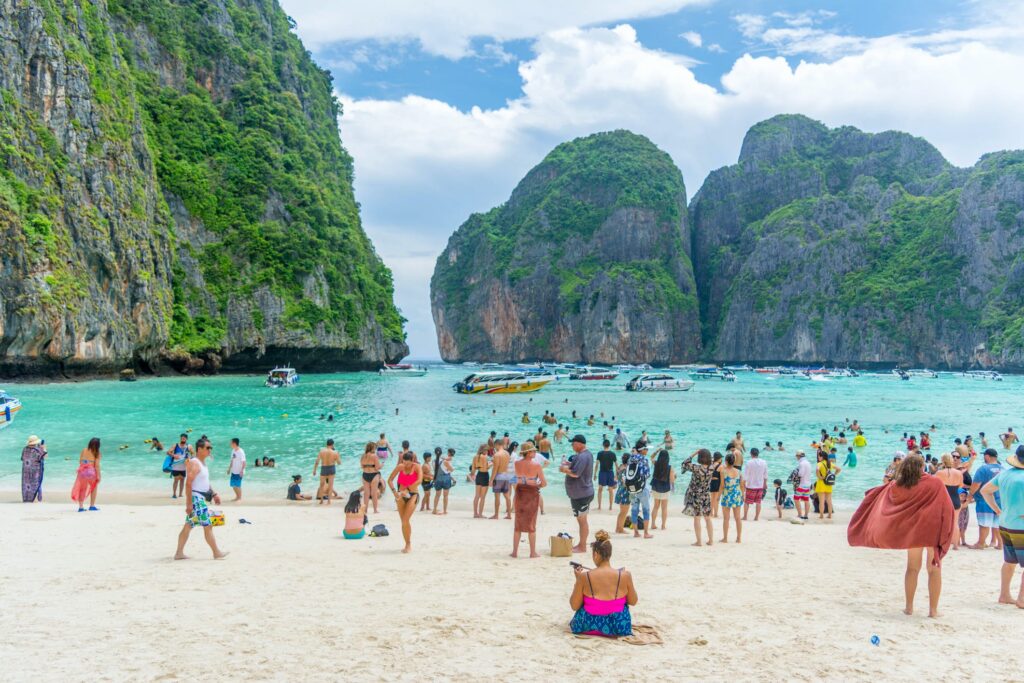After a four-year closure to allow its marine ecosystem time to replenish itself, one of the country’s most famous beaches is back, but with some stringent rules in place

A high-pitched sound pierces Maya Bay, carrying across the water and echoing off the limestone cliffs that surround this world-renowned beach. A group of Thai tourists are thigh-deep in the sea, admiring what appears to be a tiny shark. As they turn around, startled by the lifeguard whistle that signals they’ve broken a new no-swimming rule, the creature glides away into a pristine and empty stretch of ocean.
The last time I was here, eight years ago, Thailand’s Maya Bay, which was made famous by the Leonardo DiCaprio film The Beach, was populated not by marine life, but by dozens of smoke-spewing longtail boats, which ferried the hordes of noisy tourists who cloaked this beach. That disappointing experience in 2014 shocked me owing to the huge contrast with my first visit to Maya Bay. Back in 2006, I found it comparatively silent and uncrowded. It was a majestic place.
:quality(70)/cloudfront-eu-central-1.images.arcpublishing.com/thenational/PV7NFDMJJGEPD3ZKAZFK5HEG4Y.jpg)
Then mass tourism soiled this paradise, which is part of the spectacular Phi Phi Islands, in the Andaman Sea midway between the travel hotspots of Phuket to its west and Krabi to its east. Maya Bay, on Phi Phi Leh island, became increasingly polluted by endless visitors and vessels. Thai scientists discovered that its marine life was dwindling and its coral reefs were being decimated.
In June 2018, action was taken: Maya Bay was closed to tourists, initially for four months to give its marine ecosystem time to recover. But as the crowds cleared, the true extent of their impact on this marine ecosystem became apparent and the closure was extended to January 2022.
Now, Maya Bay is back, with a new, more eco-friendly tourism strategy in place. I was sceptical about its makeover before I visited in February, expecting to see large crowds and old destructive behaviours creeping in. Fortunately, the Thai authorities have done a good job of not only allowing Maya Bay time to replenish itself, but in introducing strict new rules that, if maintained, should preserve this natural gem for generations to come.
:quality(70)/cloudfront-eu-central-1.images.arcpublishing.com/thenational/ZJRM75MY6ZCPHOJMV2OITOPISE.jpg)
Boats can no longer moor inside Maya Bay, swimming in its waters is banned and tourists can only stay there for one hour. Visitors must pre-book an entry pass costing Dh45 using a Thai government app, and then arrive by boat on the opposite side of Phi Phi Leh island before walking through the jungle to this famed strip of sand.
The scale of tourism here prior to Maya Bay’s closure was astonishing. The Phi Phi Islands are petite, more than 40 times smaller in land area than Phuket island. Yet, in 2017 alone, they received 1.7 million tourists, most of whom visited Maya Bay. I find this information at the Marine Discovery Centre at SAii Phi Phi Island Village Resort on Phi Phi Don, the largest of the Phi Phi islands.
This impressive beachfront property, which opened early last year after a comprehensive makeover of an old resort, is symbolic of the change in attitude towards tourism and environmental preservation in the Phi Phi Islands. SAii has a marine biologist on staff and has been involved in local conservation efforts, including the Save Our Sharks campaign.
:quality(70)/cloudfront-eu-central-1.images.arcpublishing.com/thenational/ERDQCSZ5CJEQZMNXHTU7Q43DLA.jpg)
That project aims to protect the Andaman Sea’s endangered bamboo shark. This small species, typically only 60 centimetres to 70cm long, may be what those Thai visitors were entranced by at Maya Bay before they received that warning whistle.
There has rarely been a better moment to visit the Phi Phi Islands. While its environment has been recovering, its infrastructure has been upgraded, with a host of new accommodation options. SAii Phi Phi Island Village Resort is the most luxurious property to open here during the pandemic.
The resort is flanked on one side by jungle-draped hills and on the other by a 600 metre-long sandy beach. From my luxurious one-bedroom villa, which has its own pool and a large lounge overlooking a valley, all I can hear is the occasional rustle of the long-tailed macaques that lived in the surrounding trees.READ MOREWhat it’s like to travel to Phuket during the pandemic
SAii staff secure my entry pass to Maya Bay, which would otherwise have been a difficult task owing to the absence of an English language option on the government app that approves visitors. One of SAii’s traditional Thai longtail boats meets me outside the resort’s Api beachfront restaurant and takes me on an illuminating tour of Phi Phi Leh.
While I am not allowed to take a dip at Maya Bay, this tour includes a sequence of phenomenal swimming and snorkelling locations on the eastern and southern sides of Phi Phi Leh. After four hours in this once-ruined location, I return to my villa at SAii with a smile. Maya Bay is back in fine health. Just like when I fell in love with it at first sight, 18 years ago.


